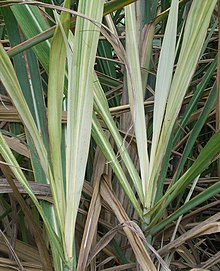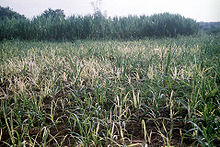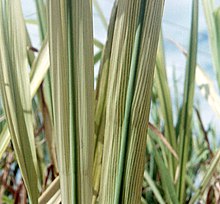Sugarcane grassy shoot disease
A higher incidence of SCGS has been recorded in some parts of Southeast Asia and India, resulting in 100% loss in cane yield and sugar production.
A survey of various fields of western Maharashtra showed grassy shoot with chlorotic or creamy white leaves was the most prevalent phenotype in sugarcane plants infected with SCGS.
[1][2][3] Phytoplasmas formerly called mycoplasma-like organisms (MLOs), are a large group of obligate, intracellular, cell wallless parasites classified within the class Mollicutes.
[9][10] Saccharosydne saccharivora,[11] Matsumuratettix hiroglyphicus,[12] Deltocephalus vulgaris[13] and Yamatotettix flavovittatus[14] have been confirmed as vectors for phytoplasma transmission in sugarcane.
Though reliable, DNA hybridization,[16] electron microscopy[10] and PCR[17] techniques require specialized equipment and trained human resources.
In recent years, regions of the rRNA operon of the prokaryotic and eukaryotic organisms have been sequenced and are being used to develop PCR-based detection assays.
The ribosomal DNA contains one transcriptional unit with a cluster of genes coding for the 18S, 5.8S and 28S rRNAs and two internal transcribed spacer regions, ITS1 and ITS2[18] in eukaryotes, and for 16S, 5S and 23S in prokaryotes .
Previous studies have demonstrated the complex ITS regions are useful in measuring close genealogical relationships because they exhibit greater interspecies differences than the smaller and larger subunits of rRNA genes.
[8] The use of specific probes as selective PCR primers offers an impressive approach for the rapid identification of a large number of phytoplasma isolates.
Reports that the disease spreads through steel blades used for sugarcane harvesting are unconfirmed, but treating the knives using a disinfectant or by dipping them in boiling water for some time is suggested as a precaution.


